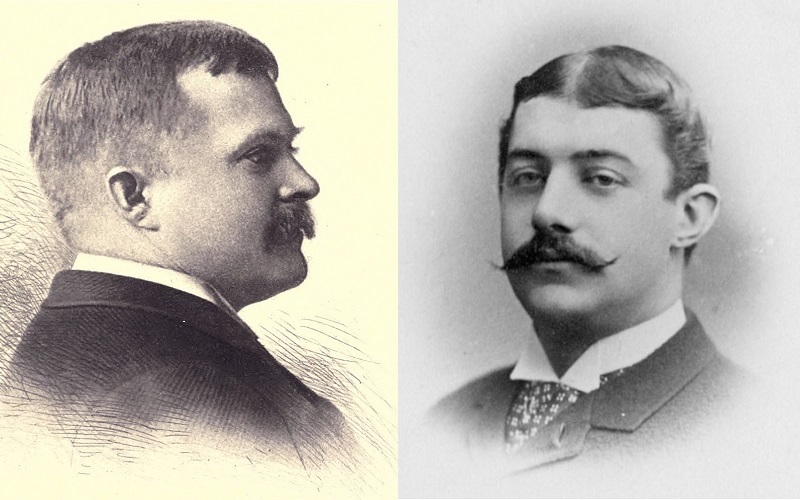Two pillars of the 1893 World’s Fair died unexpectedly before they could complete their work on the fairgrounds. Even the preliminary architectural contributions of both men, however, played a monumental role in the success of the Columbian Exposition. So, it was fitting that a small monument to the memory of these two leading designers graced the fairgrounds.

John Wellborn Root (left) and Henry Sargent Codman (right).
Glorious achievements
January 13 marks the anniversary of the death of landscape architect Henry Sargent Codman in 1893 due to complications following an appendectomy. A 29-year-old protégé of Frederick Law Olmsted, Codman influenced the shape of the Columbian Exposition fairgrounds in substantial and creative ways. World’s Fair historian Rossiter Johnson describes the young designer:
“Mr. Codman was very valuable to the Exposition. He had high qualities as an artist and as a man, and not only was well trained in his profession, but was of much service in administration and in executive functions. He judged men accurately, and had the natural power of command over them.”
January 15 marks the anniversary of the death of architect John Wellborn Root in 1891 from pneumonia at age 41.* As Consulting Architect with his partner Daniel Burnham, Root’s invaluable contributions are recorded by Harriet Monroe in her chapter “The World’s Columbian Exposition” in John Wellborn Root: A Study of His Life and Work (Houghton, Mifflin & Company, 1896), reprinted here.
A view of the Columbian Fountain by Frederick MacMonnies, looking southeast, showing one of the columns surmounted by an eagle. No names are visible on the column.
Simple inscriptions
Both Burnham and Olmsted were devastated by the loss of the respective partners. An idea emerged to honor them within the architecture of the White City. Daniel Burnham recorded this description of the memorial:
“There are two columns east of the Administration Building; between them rolls the cascade of the Columbia Fountain. Each column bears a name; upon one, that of John W. Root; upon the other, Henry Sargent Codman. One of these men laid down his work where it had scarcely begun, leaving the first sketches of his brilliant plans; the other passed away with the beauty of his almost finished labors bright before him. These simple inscriptions mean more to us who knew and loved the men to whose memory they are placed, than all the glorious achievements about them, of which so great a part was theirs.” [Burnham, 32] Flanking the north and south sides of the MacMonnies Fountain stood a pair of columns to the west of the central barge of state sculpture. Each column was surmounted by an eagle. However, images of these columns do not show the names of Root and Codman.
A pair of markers honoring the two architects is known to have graced the south entrance to the Palace of Fine Arts. Perhaps Burnham simply made a mistake in locating the memorial plaques? Or perhaps they were moved at some point? Or did markers exist in both locations?
The bronze tablets honoring the memory of John Root and Henry Codman. [Images from Rossiter Johnson’s History of the World’s Columbian Exposition Held in Chicago in 1893, Volume 1 (Appleton, 1897).]
In Loving Remembrance
Rossiter Johnson records that “two bronze tablets were set up against the supporting piers of the great south doorway of the Art Building in Jackson Park—one in memory of John Wellborn Root and one of Henry Sargent Codman.” [Johnson, 148]
One reads:
IN LOVING REMEMBRANCE OF
JOHN WELLBORN ROOT
ARCHITECT
AND ONE OF THE LEADING DESIGNERS OF
THE WORLD’S COLUMBIAN EXPOSITION
WHO DIED JANUARY 15TH 1891
THIS TABLET IS HERE PLACED BY HIS
BROTHER ARTISTS
The second reads:
IN LOVING REMEMBRANCE OF
HENRY SARGENT CODMAN
LANDSCAPE ARCHITECT
AND ONE OF THE LEADING DESIGNERS OF
THE WORLD’S COLUMBIAN EXPOSITION
WHO DIED JANUARY 13TH 1891
THIS TABLET IS HERE PLACED BY HIS
BROTHER ARTISTS
The south facade of the Palace of Fine Arts during the 1893 World’s Fair, showing the locations of the bronze tablets. [Image from Jackson, William Henry Jackson’s Famous Pictures of the World’s Fair (White City Art Co., 1895).]
After the Field Museum of Natural History moved to their new downtown Chicago home in 1920, the old Art Palace remained empty. A massive restoration project in the early 1930s rebuilt the structure to serve as the home of the new Museum of Science and Industry (MSI). At some point during this transition, the memorial plaques were removed.
Detail of a photograph of the Palace of Fine Arts after the World’s Columbian Exposition (note that statuary has been removed), showing the Root and Codman memorial tablets still mounted on either side of the central door. [Image from the Ryerson & Burnham Archives.]
Bronze tablets lost
What happened to the pair of bronze tablets? Had the names of Root and Codman faded so much by 1920 that the memorial plaques were discarded? Or are they hiding away in storage in some city institute, such as the Field Museum or MSI?
We welcome readers with any information about the fate of the John Root and Henry Codman memorial bronze tablets to share their knowledge. We’ll post this in our “Lost & Found” page.
Restoration of the old Palace of Fine Arts in the early 1930s rebuilt the structure into the Museum of Science and Industry. [Image from MSI.]
SOURCES
Burnham, Daniel “The Buildings of the Exposition” in Rand, McNally & Co.’s A Week at the Fair: Illustrating Exhibits and Wonders of the World’s Columbian Exposition, with Special Descriptive Articles. Rand, McNally & Co., 1893, pp. 31-32.
https://chuckmanchicagonostalgia.wordpress.com/
Johnson, Rossiter History of the World’s Columbian Exposition Held in Chicago in 1893, Volume 1: Narrative. Appleton, 1897.
Larson, Erik The Devil in the White City: Murder, Magic, and Madness at the Fair that Changed America. Crown, 2003.
